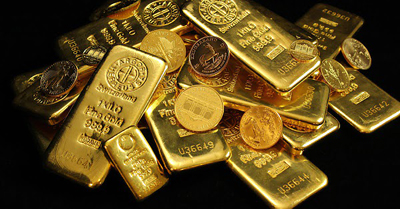Why we could easily see $5,000+ gold
Simon Black
 On the 18th of September, in the year 324 AD, 52-year old Constantine the Great finally won the victory that he had been fighting for two decades to achieve: sole control of the Roman Empire. On the 18th of September, in the year 324 AD, 52-year old Constantine the Great finally won the victory that he had been fighting for two decades to achieve: sole control of the Roman Empire.
At that point the Roman Empire had suffered more than a century of extreme turmoil– recession, inflation, invasion, humiliation, and endless civil wars, just to name a few of its challenges.
But after finally vanquishing his remaining political opponents, Constantine was ready to turn the page and institute some much needed reforms. And one of his first orders of business was to restore much-needed confidence in the currency.
Previous emperors had heavily debased Rome’s coinage to almost hilarious levels; the silver content in the denarius coin, for example, had been reduced 98% purity, all the way down to just 5% purity.
Nobody trusted Roman currency anymore. So in order to restore confidence, Constantine turned to gold.
The solidus gold coin had been originally introduced by one of his more notorious predecessors– Diocletian– in the early 300s. But the coin wasn’t really widely used.
Constantine chose the solidus as the gold standard for Roman currency, and he minted large quantities of it for circulation across the empire. More importantly, he standardized the coin at a fixed weight and high level of purity… and this standard remained untouched for centuries.
The value of the solidus was so stable, in fact, that it eventually became used for trade and commerce across the world– from the Mediterranean to the Silk Road.
By the 500s AD, the wide acceptance of the solidus became a source of pride for the Empire, leading one emperor to comment that the solidus was “accepted everywhere from end to end of the earth”, and that the coin was “admired by all men in all kingdoms, because no kingdom has a currency that can be compared to it.”
And he was right. Only the solidus was as widely accepted for international trade… sort of like the US dollar’s status today.
The solidus certainly had a great run; its dominance lasted for centuries. But ultimately, as the Roman Empire (then known as the Byzantine Empire) decayed, emperors once again began to debase the solidus.
Over a period of about three decades in the mid 11th century, the solidus lost roughly two-thirds of its value.
This was a time in history when there were other rising powers in Europe. And these foreign kingdoms started thinking about alternatives.
Soon wealthy Italian city-states like Venice and Florence began minting their own coins– the ducat and florin. And as these coins quickly gained acceptance for international trade, the Roman solidus was displaced forever.
I’ve consistently argued that the US dollar would likely suffer the same fate as the solidus ever since I started Sovereign Man.
As far back as 2012, for example, I wrote:
History’s lesson is quite simple — when the issuing authority of the world’s reserve currency engages in wanton debasement, the market seeks an alternative. This time is not different, and the dollar will suffer the same fate.
This will likely happen gradually rather than suddenly; over time, the US government will no longer be able to export the most deleterious effects of its monetary policy to destitute people in developing countries. The negative consequences will remain in the US, once and for all.
The sensible course of action is to plan for this trend by trading out paper currency for real assets like precious metals and productive land that will hold their value over time.
11 years ago when I wrote that passage, the idea of the dollar losing its reserve status was controversial. In fact, most of what I wrote back then was considered highly controversial; I said that Social Security was in serious trouble, that the US government would eventually be unable to pay its debts, and that America was in serious decline.
Today these ideas are no longer controversial. And the proof is in the news headlines on an almost daily basis.
In particular, the dollar’s potential loss as the dominant global reserve currency is now a mainstream idea that is being openly discussed around the world.
(Naturally the Federal Reserve and US Treasury Department are completely ignoring the risk altogether.)
So what does the future hold? Does loss of reserve status mean that the US dollar will simply vanish?
No, of course not. And at this point I don’t necessarily that the Chinese yuan will become THE dominant reserve currency.
China is obviously a major player in global trade and one of the largest economies in the world. They’re big. They’re powerful. And at this point, they’re able to force many of their trading partners to start using yuan for trade.
Think about it like this: Australia currently exports around $150 billion each year to China. And right now, most of that trade takes place in US dollars… because the US dollar is STILL the world’s primary reserve currency.
This means that the central banks in both China and Australia have to stockpile large amounts of US dollars in order to facilitate this trade. And this is an ENORMOUS benefit for the US economy; the rest of the world is essentially forced to invest in America.
But what if China demands that all trade with Australia now be denominated in yuan, instead of dollars. Australia certainly wouldn’t want to alienate its biggest trading partner, so they might happily agree.
What does this mean in practice? Australia makes its exports to China. Instead of receiving $150 billion US dollars, they receive $150 billion worth of Chinese yuan.
What does Australia do with all that yuan? Well, there aren’t too many options. China has a very closed economy with highly regimented capital controls. You can’t freely move money in and out of China.
Now, Australia does import around $70 billion from China each year. So the easiest option is to pay for those Chinese imports using their new pile of yuan.
But that still leaves around $80 billion worth of yuan left over. And again, since it’s so difficult to invest that money in China, Australia will need to figure out something to do with it.
One solution is that Australia’s central bank could exchange its excess yuan for gold. Gold is a traditional asset that central banks around the world have always held. They can use it to settle debts and trade accounts, or simply keep it as a reserve.
So what does this mean for the gold price? Well, the math is fairly simple. China’s global trade surplus in 2022 was nearly $900 billion.
As China continues to push its trading partners to accept yuan, if even 20% of that trade surplus ends up being exchanged for gold, we could easily see a $5,000 gold price given gold’s current supply and demand fundamentals.
I’ll discuss this much more in future letters, but if you’re thinking about ways to hedge the risk of the US dollar losing some of its dominance as the world’s reserve currency, gold is a good place to start.
 Hi. I’m Simon Black– founder of Sovereign Man, international entrepreneur, investor, permanent traveler, and a free man. Hi. I’m Simon Black– founder of Sovereign Man, international entrepreneur, investor, permanent traveler, and a free man.
On average, I travel to over 40 countries per year…doing business, investing, exploring emerging markets, and establishing and maintaining important relationships.
Just to give you a brief snapshot, some of the things I’ve done recently include…
Starting my own private investment bank
Negotiating an eight figure financing deal with one of the largest financial institutions in the world
Meeting with the former President of Colombia at his home
Leading an investor group to take a controlling stake in a public company
And speaking on stage to thousands of people alongside Rich Dad, Poor Dad author, Robert Kiyosaki
Everything I learn from these valuable experiences is passed on to readers of Sovereign Man in our free newsletter, Notes from the Field, and in our highly actionable and educational premium products.
www.sovereignman.com
| 

